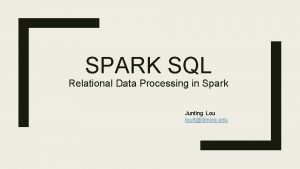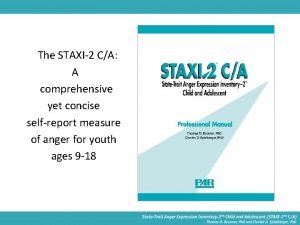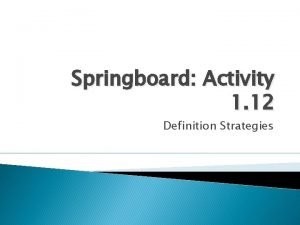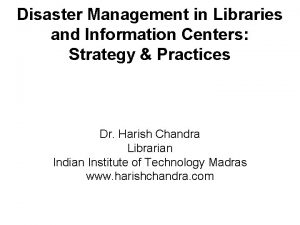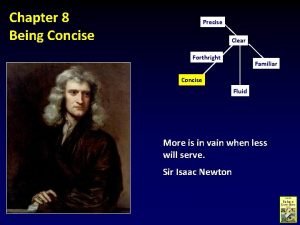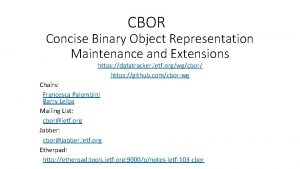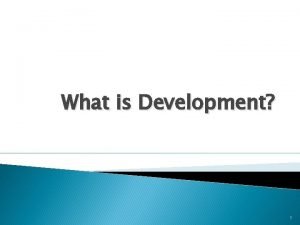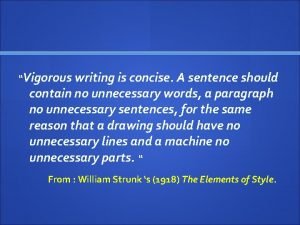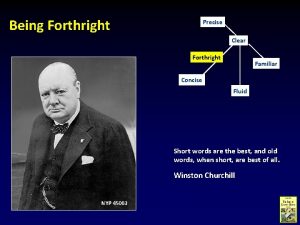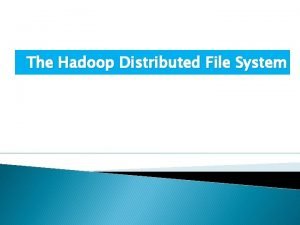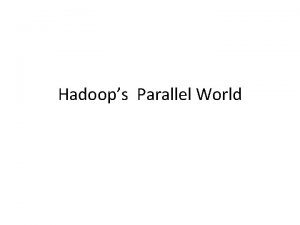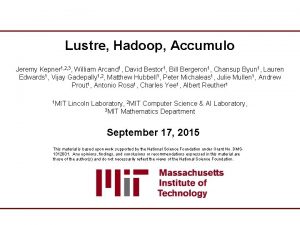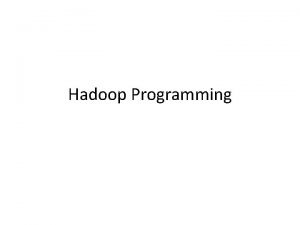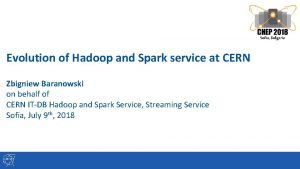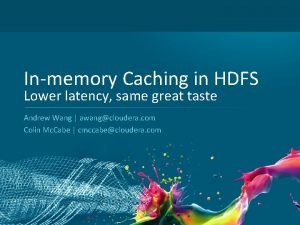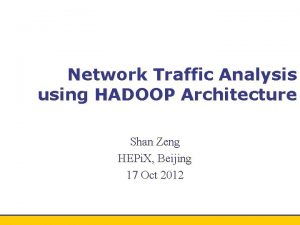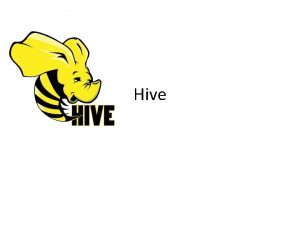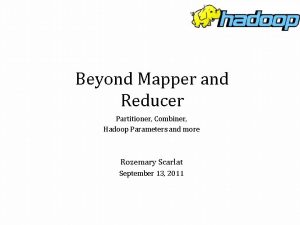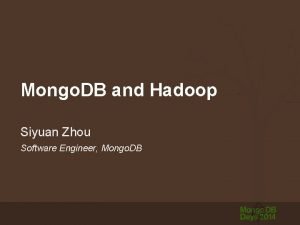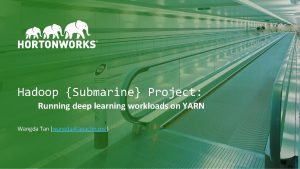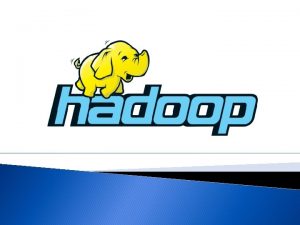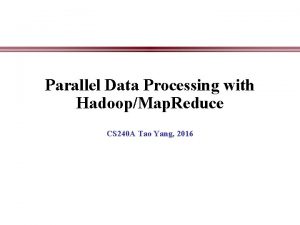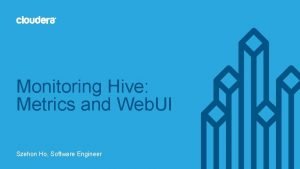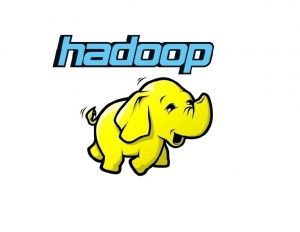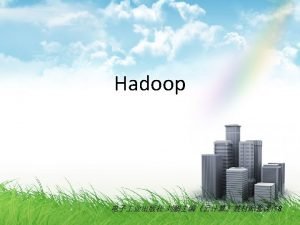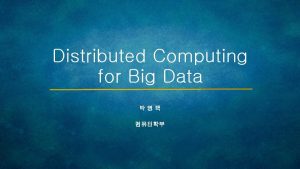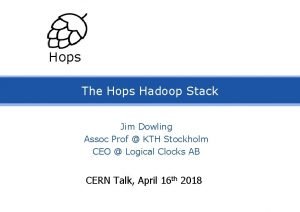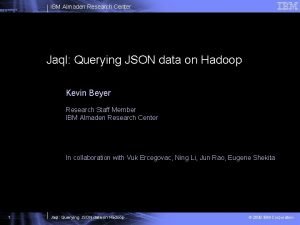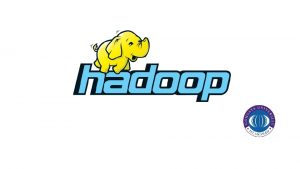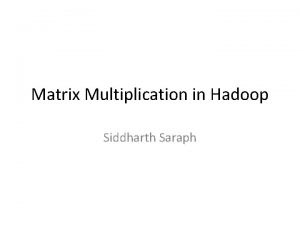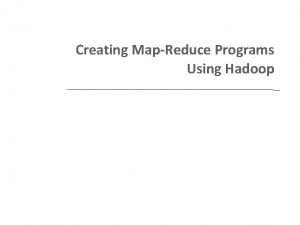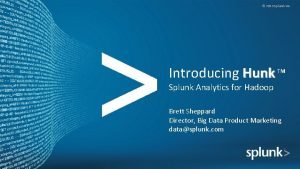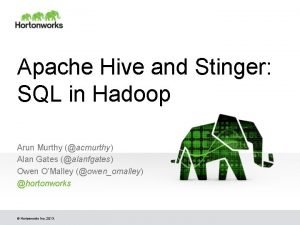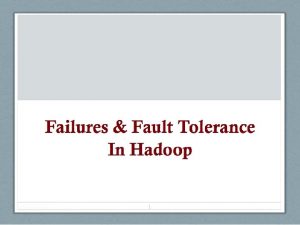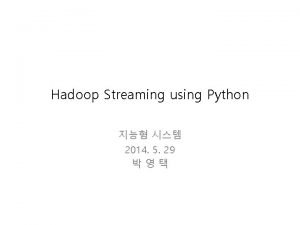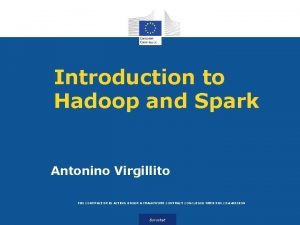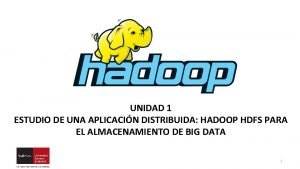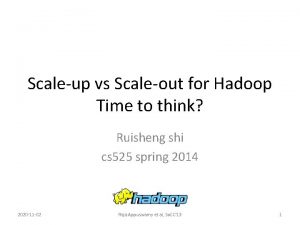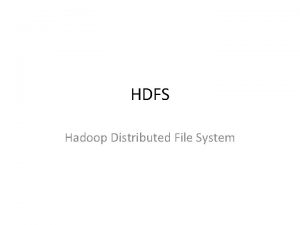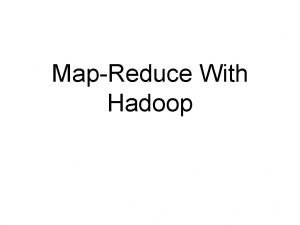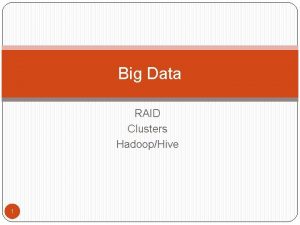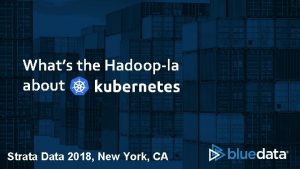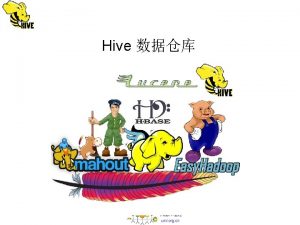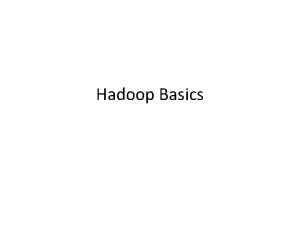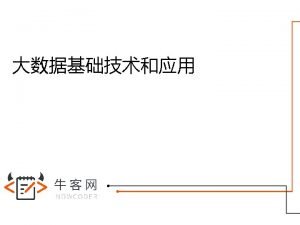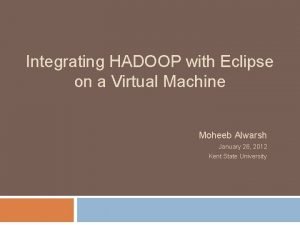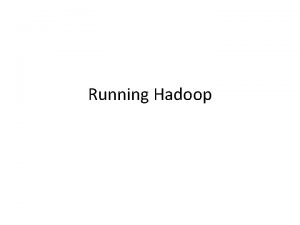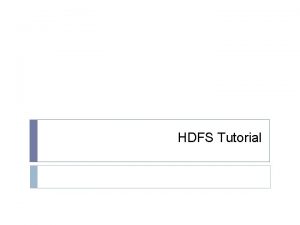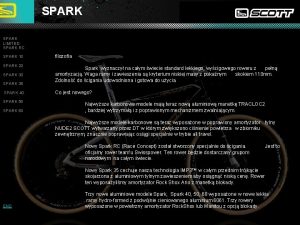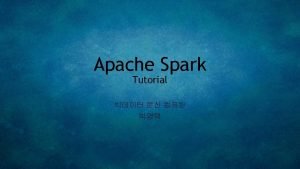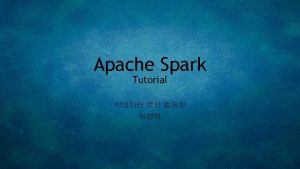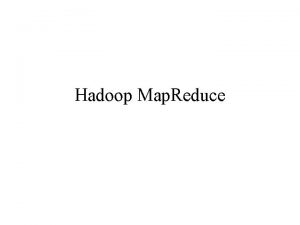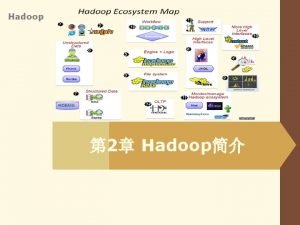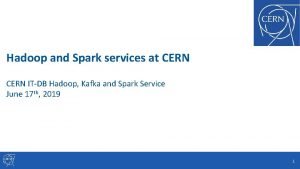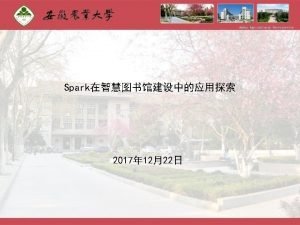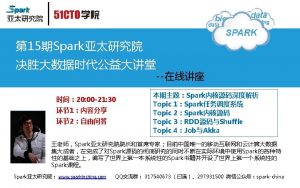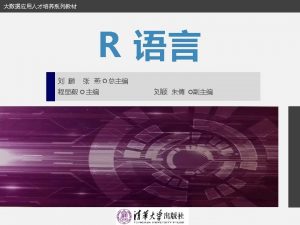Spark vs Hadoop 1 Spark Set of concise























































































- Slides: 87

Spark vs Hadoop 1

Spark Set of concise dataflow operations (“transformation”) • Too much typing – programs are not concise Dataflow operations are embedded in an • Too low level API together with – missing abstractions “actions” – hard to specify a workflow • Not well suited to iterative operations – E. g. , E/M, k-means clustering, … – Workflow and memory-loading issues Sharded files are replaced by “RDDs” – resiliant distributed datasets RDDs can be cached in cluster memory and recreated to 2

Spark examples spark is a spark context object 3

Spark examples errors is a transformation, and thus a data strucure count() is an action: that explains HOW it will actually to do something execute the plan for errors and return a value. everything is sharded, like in Hadoop and Guinea. Pig errors. filter() is a transformation collect() is an action 4

Spark examples everything is sharded … and the shards are stored in memory of worker machines not local disk (if possible) # modify errors to be stored in cluster memory You can also persist() an RDD on disk, which is like marking it as opts(stored=True) in Guinea. Pig. Spark’s not smart about persisting data. subsequent actions will be much faster 5

Spark examples: wordcount the action transformation on (key, value) pairs , which are special 6

Spark examples: batch logistic regression reduce is an action – it produces a numpy vector p. xwand are p. x and are w vectors, from the numpy package. Python overloads operations like * and + for vectors. 7

Spark examples: batch logistic regression Important note: numpy vectors/matrices are not just “syntactic sugar”. • They are much more compact than something like a list of python floats. • numpy operations like dot, *, + are calls to optimized C code • a little python logic around a lot of numpy calls is pretty 8

Spark examples: batch logistic regression So: python builds a closure – code including the current value of w – and Spark ships it off to each worker. So w is copied, and must be read-only. w is defined outside the lambda function, but used inside it 9

Spark examples: batch logistic regression dataset of points is cached in cluster memory to reduce i/o 10

Spark logistic regression example 11

Spark 12

Other Map-Reduce (ish) Frameworks William Cohen 17

MAP-REDUCE ABSTRACTIONS: CASCADING, PIPES, SCALDING 18

Y: Y=Hadoop+X • Cascading – Java library for map-reduce workflows – Also some library operations for common mappers/reducers 19

Cascading Word. Count Example Input format Bind to HFS path Output format: pairs Bind to HFS path A pipeline of map-reduce jobs Replace line with bag of words Append a step: apply function to the “line” field Append step: group a (flattened) stream of “tuples” Append step: aggregate grouped values Run the pipeline 20

Cascading Word. Count Example Many of the Hadoop abstraction levels have a similar flavor: • Define a pipeline of tasks declaratively • Optimize it automatically • Run the final result The key question: does the system successfully hide the details from you? Is this inefficient? We explicitly form a group for each word, and then count the elements…? We could be saved by careful optimization: we know we don’t need the Group. By intermediate result when we run the assembly…. 21

Y: Y=Hadoop+X • Cascading – Java library for map-reduce workflows • expressed as “Pipe”s, to which you add Each, Every, Group. By, … – Also some library operations for common mappers/reducers • e. g. Regex. Generator – Turing-complete since it’s an API for Java • Pipes – C++ library for map-reduce workflows on Hadoop • Scalding – More concise Scala library based on Cascading 22

MORE DECLARATIVE LANGUAGES 23

Hive and PIG: word count • Declarative …. . Fairly stable PIG program is a bunch of assignments where every LHS is a relation. 24

FLINK • Recent Apache Project – formerly Stratosphere …. 25

Java API FLINK • Apache Project – just getting started …. 26

FLINK 27

FLINK • Like Spark, in-memory or on disk • Everything is a Java object • Unlike Spark, contains operations for iteration – Allowing query optimization • Very easy to use and install in local model – Very modular – Only needs Java 28

One more algorithm to discuss as a Map-reduce implementation…. 29

30

32

Why phrase-finding? • There are lots of phrases • There’s not supervised data • It’s hard to articulate – What makes a phrase, vs just an ngram? • a phrase is independently meaningful (“test drive”, “red meat”) or not (“are interesting”, “are lots”) – What makes a phrase interesting? 33

The breakdown: what makes a good phrase • Two properties: – Phraseness: “the degree to which a given word sequence is considered to be a phrase” • Statistics: how often words co-occur together vs separately – Informativeness: “how well a phrase captures or illustrates the key ideas in a set of documents” – something novel and important relative to a domain • Background corpus and foreground corpus; how often phrases occur in each 34

“Phraseness” 1 – based on BLRT • Binomial Ratio Likelihood Test (BLRT): – Draw samples: • n 1 draws, k 1 successes • n 2 draws, k 2 successes • Are they from one binominal (i. e. , k 1/n 1 and k 2/n 2 were different due to chance) or from two distinct binomials? – Define • p 1=k 1 / n 1, p 2=k 2 / n 2, p=(k 1+k 2)/(n 1+n 2), • L(p, k, n) = pk(1 -p)n-k 35

“Phraseness” 1 – based on BLRT • Binomial Ratio Likelihood Test (BLRT): – Draw samples: • n 1 draws, k 1 successes • n 2 draws, k 2 successes • Are they from one binominal (i. e. , k 1/n 1 and k 2/n 2 were different due to chance) or from two distinct binomials? – Define • pi=ki/ni, p=(k 1+k 2)/(n 1+n 2), • L(p, k, n) = pk(1 -p)n-k 36

“Informativeness” 1 – based on BLRT Phrase x y: W 1=x ^ W 2=y and two corpora, C and B – Define • pi=ki /ni, p=(k 1+k 2)/(n 1+n 2), • L(p, k, n) = pk(1 -p)n-k comment k 1 C(W 1=x ^ W 2=y) how often bigram x y occurs in corpus C n 1 C(W 1=* ^ W 2=*) how many bigrams in corpus C k 2 B(W 1=x^W 2=y) how often x y occurs in background corpus n 2 B(W 1=* ^ W 2=*) how many bigrams in background corpus Does x y occur at the same frequency in both corpora? 37

“Phraseness” 1 – based on BLRT Phrase x y: W 1=x ^ W 2=y – Define • pi=ki /ni, p=(k 1+k 2)/(n 1+n 2), • L(p, k, n) = pk(1 -p)n-k comment k 1 C(W 1=x ^ W 2=y) how often bigram x y occurs in corpus C n 1 C(W 1=x) how often word x occurs in corpus C k 2 C(W 1≠x^W 2=y) how often y occurs in C after a non-x n 2 C(W 1≠x) how often a non-x occurs in C Does y occur at the same frequency after x as in other positions? 38

The breakdown: what makes a good phrase • “Phraseness” and “informativeness” are then combined with a tiny classifier, tuned on labeled data. • Background corpus: 20 newsgroups dataset (20 k messages, 7. 4 M words) • Foreground corpus: rec. arts. movies. current-films June-Sep 2002 (4 M words) • Results? 39

40

The breakdown: what makes a good phrase • Two properties: – Phraseness: “the degree to which a given word sequence is considered to be a phrase” • Statistics: how often words co-occur together vs separately – Informativeness: “how well a phrase captures or illustrates the key ideas in a set of documents” – something novel and important relative to a domain • Background corpus and foreground corpus; how often phrases occur in each – Another intuition: our goal is to compare distributions and see how different they are: • Phraseness: estimate x y with bigram model or unigram model • Informativeness: estimate with foreground vs background corpus 41

The breakdown: what makes a good phrase – Another intuition: our goal is to compare distributions and see how different they are: • Phraseness: estimate x y with bigram model or unigram model • Informativeness: estimate with foreground vs background corpus – To compare distributions, use KL-divergence “Pointwise KL divergence” 42

The breakdown: what makes a good phrase – To compare distributions, use KL-divergence “Pointwise KL divergence” Bigram model: Phraseness: difference between bigram and unigram language model in foreground P(x y)=P(x)P(y|x) Unigram model: P(x y)=P(x)P(y) 43

The breakdown: what makes a good phrase – To compare distributions, use KL-divergence Informativeness: difference between foreground and background models “Pointwise KL divergence” Bigram model: P(x y)=P(x)P(y|x) Unigram model: P(x y)=P(x)P(y) 44

The breakdown: what makes a good phrase – To compare distributions, use KL-divergence “Pointwise KL divergence” Bigram model: Combined: difference between foreground bigram model and background unigram model P(x y)=P(x)P(y|x) Unigram model: P(x y)=P(x)P(y) 45

The breakdown: what makes a good phrase – To compare distributions, use KL-divergence Subtle advantages: • BLRT scores “more frequent in foreground” and “more frequent in background” symmetrically, pointwise KL does not. • Phrasiness and informativeness scores are more comparable – straightforward combination w/o a classifier is reasonable. • Language modeling is well-studied: • extensions to n-grams, smoothing methods, … • we can build on this work in a modular way Combined: difference between foreground bigram model and background unigram model 46

Pointwise KL, combined 47

Why phrase-finding? • Phrases are where the standard supervised “bag of words” representation starts to break. • There’s not supervised data, so it’s hard to see what’s “right” and why • It’s a nice example of using unsupervised signals to solve a task that could be formulated as supervised learning • It’s a nice level of complexity, if you want to do it in a scalable way. 48

Phrase Finding in Guinea Pig 49

Phrase Finding 1 – counting words background corpus 50

Phrase Finding 2 – counting phrases 51

Phrase Finding 3 – collecting info dictionary: {‘statistic name’: value} returns copy with a new key, value pair 52

Phrase Finding 3 – collecting info join fg and bg phrase counts and output a dict join fg and bg count for first word “x” in “x y” 53

Phrase Finding 3 – collecting info join fg and bg count for word “y” in “x y” 54

Phrase Finding 4 – totals MAP REDUCE (‘const’, 6743324) 55

Phrase Finding 4 – totals MAP COMBINE 56

Phrase Finding 4 – totals 57

Phrase Finding 4 – totals (map-side) 58

Phrase Finding 5 – collect totals 59

Phrase Finding 6 – compute …. 60

Phrase Finding results Overall Phrasiness Only Top 100 phraseiness, lo informativeness 61

Phrase Finding results Overall Top 100 informativeness, lo phraseiness 62

The full phrase-finding pipeline 63

The full phrase-finding pipeline 64

The full phrase-finding pipeline 65

Phrase Finding in PIG 66

Phrase Finding 1 - loading the input 67


PIG Features • comments -- like this /* or like this */ • ‘shell-like’ commands: – fs -ls … -- any hadoop fs … command – some shorter cuts: ls, cp, … – sh ls -al -- escape to shell 69


PIG Features • comments -- like this /* or like this */ • ‘shell-like’ commands: – fs -ls … -- any hadoop fs … command – some shorter cuts: ls, cp, … – sh ls -al -- escape to shell • LOAD ‘hdfs-path’ AS (schema) – schemas can include int, double, … – schemas can include complex types: bag, map, tuple, … • FOREACH alias GENERATE … AS …, … – transforms each row of a relation – operators include +, -, and, or, … – can extend this set easily (more later) • DESCRIBE alias -- shows the schema • ILLUSTRATE alias -- derives a sample tuple 71

Phrase Finding 1 - word counts 72

73

PIG Features • LOAD ‘hdfs-path’ AS (schema) – schemas can include int, double, bag, map, tuple, … • FOREACH alias GENERATE … AS …, … – transforms each row of a relation • DESCRIBE alias/ ILLUSTRATE alias -- debugging • GROUP r BY x – like a shuffle-sort: produces relation with fields group and r, where r is a bag 74

PIG parses and optimizes a sequence of commands before it executes them It’s smart enough to turn GROUP … FOREACH… SUM … into a map-reduce 75

PIG Features • LOAD ‘hdfs-path’ AS (schema) – schemas can include int, double, bag, map, tuple, … • FOREACH alias GENERATE … AS …, … – transforms each row of a relation • DESCRIBE alias/ ILLUSTRATE alias -- debugging • GROUP alias BY … • FOREACH alias GENERATE group, SUM(…. ) – GROUP/GENERATE … aggregate op together act like a map-reduce – aggregates: COUNT, SUM, AVERAGE, MAX, MIN, … – you can write your own 76

PIG parses and optimizes a sequence of commands before it executes them It’s smart enough to turn GROUP … FOREACH… SUM … into a map-reduce 77

Phrase Finding 3 - assembling phrase- and word-level statistics 78

79

80

PIG Features • LOAD ‘hdfs-path’ AS (schema) – schemas can include int, double, bag, map, tuple, … • FOREACH alias GENERATE … AS …, … – transforms each row of a relation • DESCRIBE alias/ ILLUSTRATE alias -- debugging • GROUP alias BY … • FOREACH alias GENERATE group, SUM(…. ) – GROUP/GENERATE … aggregate op together act like a map-reduce • JOIN r BY field, s BY field, … – inner join to produce rows: r: : f 1, r: : f 2, … s: : f 1, s: : f 2, … 81

Phrase Finding 4 - adding total frequencies 82

83

How do we add the totals to the phrase. Stats relation? STORE triggers execution of the query plan…. it also limits optimization 84

Comment: schema is lost when you store…. 85

PIG Features • LOAD ‘hdfs-path’ AS (schema) – schemas can include int, double, bag, map, tuple, … • FOREACH alias GENERATE … AS …, … – transforms each row of a relation • DESCRIBE alias/ ILLUSTRATE alias -- debugging • GROUP alias BY … • FOREACH alias GENERATE group, SUM(…. ) – GROUP/GENERATE … aggregate op together act like a mapreduce • JOIN r BY field, s BY field, … – inner join to produce rows: r: : f 1, r: : f 2, … s: : f 1, s: : f 2, … • CROSS r, s, … – use with care unless all but one of the relations are singleton – newer pigs allow singleton relation to be cast to a scalar 86

Phrase Finding 5 - phrasiness and informativeness 87

How do we compute some complicated function? With a “UDF” 88

89

PIG Features • LOAD ‘hdfs-path’ AS (schema) – schemas can include int, double, bag, map, tuple, … • FOREACH alias GENERATE … AS …, … – transforms each row of a relation • DESCRIBE alias/ ILLUSTRATE alias -- debugging • GROUP alias BY … • FOREACH alias GENERATE group, SUM(…. ) – GROUP/GENERATE … aggregate op together act like a mapreduce • JOIN r BY field, s BY field, … – inner join to produce rows: r: : f 1, r: : f 2, … s: : f 1, s: : f 2, … • CROSS r, s, … – use with care unless all but one of the relations are singleton • User defined functions as operators – also for loading, aggregates, … 90

The full phrase-finding pipeline in PIG 91

92
 File based data structures in hadoop
File based data structures in hadoop Total set awareness set consideration set
Total set awareness set consideration set Training set validation set test set
Training set validation set test set Spark sql: relational data processing in spark
Spark sql: relational data processing in spark Short but concise
Short but concise Staxi2
Staxi2 Concise definition
Concise definition Answer key
Answer key Concise precise
Concise precise Objectives vs deliverables
Objectives vs deliverables Concise diction
Concise diction Disaster management in libraries and information centres
Disaster management in libraries and information centres Concise history of western music 5th edition
Concise history of western music 5th edition Concise style
Concise style Being concise
Being concise Concise binary object representation
Concise binary object representation Development is relatively orderly
Development is relatively orderly Concise thesis statement
Concise thesis statement Vigorous in a sentence
Vigorous in a sentence Forthright tone
Forthright tone Concise writing style
Concise writing style Vigorous sentence
Vigorous sentence Fuzzy theory
Fuzzy theory The function from set a to set b is
The function from set a to set b is Crisp set vs fuzzy set
Crisp set vs fuzzy set Crisp set vs fuzzy set
Crisp set vs fuzzy set Bounded set vs centered set
Bounded set vs centered set What is the overlap of data set 1 and data set 2?
What is the overlap of data set 1 and data set 2? Hadoop distributed file system architecture design
Hadoop distributed file system architecture design Hadoop parallel world
Hadoop parallel world Hadoop has two major layers namely
Hadoop has two major layers namely Supercloud hadoop
Supercloud hadoop Filters in weka
Filters in weka Ruby hadoop
Ruby hadoop Input formats in hadoop
Input formats in hadoop Evolution of hadoop
Evolution of hadoop Spotify hadoop
Spotify hadoop Hadoop hdfs latency
Hadoop hdfs latency Hadoop netflow
Hadoop netflow Hadoop 101
Hadoop 101 Hadoop file formats
Hadoop file formats Hadoop hive architecture
Hadoop hive architecture Ssis hadoop connection manager
Ssis hadoop connection manager Hadoop partitioner
Hadoop partitioner Apache atlas architecture
Apache atlas architecture Big data test infrastructure
Big data test infrastructure Mongodb hadoop connector java example
Mongodb hadoop connector java example Hadoop deep learning
Hadoop deep learning Hadoop open source
Hadoop open source +hadoop programming
+hadoop programming Fsck command in hadoop
Fsck command in hadoop Hive web ui
Hive web ui All of the following accurately describe hadoop except
All of the following accurately describe hadoop except Apche hadoop
Apche hadoop Distributed computing hadoop
Distributed computing hadoop Hadoop
Hadoop Jaql hadoop
Jaql hadoop Hadoop is open source
Hadoop is open source Hadoop matrix multiplication
Hadoop matrix multiplication Hadoop presentation
Hadoop presentation Hadoop distribution
Hadoop distribution Hunk vs splunk
Hunk vs splunk Stinger hadoop
Stinger hadoop Hadoop fault tolerance
Hadoop fault tolerance Hdfs chown
Hdfs chown Hadoop 설치
Hadoop 설치 Hadoop streaming python
Hadoop streaming python Intro to hadoop
Intro to hadoop Hadoop
Hadoop Hadoop timeline
Hadoop timeline Oracle loader for hadoop
Oracle loader for hadoop Scale up and scale out in hadoop
Scale up and scale out in hadoop Ambari hadoop
Ambari hadoop Hadoop ubuntu
Hadoop ubuntu Hadoop master slave architecture
Hadoop master slave architecture Apache mahout
Apache mahout Hadoop distributed file system
Hadoop distributed file system Hadoop webinar
Hadoop webinar Hadoop assignment help
Hadoop assignment help Doopfile
Doopfile Strata hadoop
Strata hadoop Eclipse 설치
Eclipse 설치 Scorecard visio
Scorecard visio Scribe hadoop
Scribe hadoop Hadoop history
Hadoop history Hadoop
Hadoop Hadoop virtual machine download
Hadoop virtual machine download Hadoop
Hadoop



